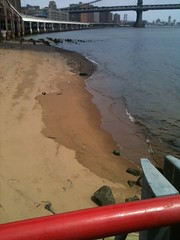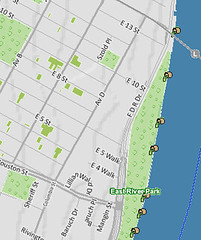 Kathryn Doyle A beach under the Brooklyn Bridge is
Kathryn Doyle A beach under the Brooklyn Bridge isinundated with sewage waste and runoff
from South Street in rainy weather
Swimming pools in the East River? Manhattan Borough President Scott Stringer floated the idea in a video introduction to the Blueway, a project that would revitalize a stretch of the East River from the Brooklyn Bridge to Midtown East. And it’s not as farfetched as you’d think: the historically polluted waterway is perfectly swimmable by Environmental Protection Agency standards. There’s just one problem: sewage overflows.
Dan Tainow, education director at the Lower East Side Ecology Center, explained the issue to local residents yesterday during a tour of the East River that doubled as a discussion of the Blueway project. Due to the age of New York City’s sewer system, he said, wastewater from household sinks, showers and toilets shares the same set of pipes as runoff from city streets.
Most of Lower Manhattan’s wastewater travels through this pipe system to the Newtown Creek plant in Greenpoint, Brooklyn, where it is cleaned, filtered and released into the East River. But during the fifty to sixty rainy days per year when gushes of street water could overwhelm the pipe system and force sewage back up into homes, the sewage is diverted directly into the East River by Combined Sewage Outflows, or CSOs.
Touching water within 48 hours of such overflows, which can be caused by as little as a tenth of an inch of rain, could put residents at risk of illness from exposure to bacteria, according to the EPA’s CSO control policy. That’s enough to put a damper on some popular ideas for the Blueway, like kayaking, boating and swimming.
Advocates of the project aim to install soil, vegetation, and other green infrastructure in order to manage rainfall as it happens. The move would reduce overflow in the 32 CSOs along the Blueway’s span, four of which are in the East Village (two more are on the border). Freshwater marshes, for instance, naturally filter and purify water, much like oysters do. “Marsh communities could be a green feature, treat the water and create habitat,” said Mr. Tainow. An “Eco Park” intertidal zone is already under construction at Pier 35, just north of the Manhattan Bridge; it’s expected to open in 2013 as part of the $165 million revitalization project on the southern part of the East River Esplanade.
Karen Lee, an architect and resident of Kips Bay, has enjoyed running in East River Park for 13 years. During yesterday’s tour, she said that the East Side waterfront has more potential than some people give it credit for, but she would like to see the NYU parking areas under the FDR near Stuyvesant Cove reclaimed by the city and made into park space – an idea that has yet to be proposed.
The LES Ecology Center has already started some projects aimed at absorbing street runoff and preventing overflows, like expanding the landscaping at the base of Catherine Street. The green space also makes the area near the FDR more appealing for community use. “We still have a behemoth of a highway here, but it’s a start,” said Mr. Tainow.




